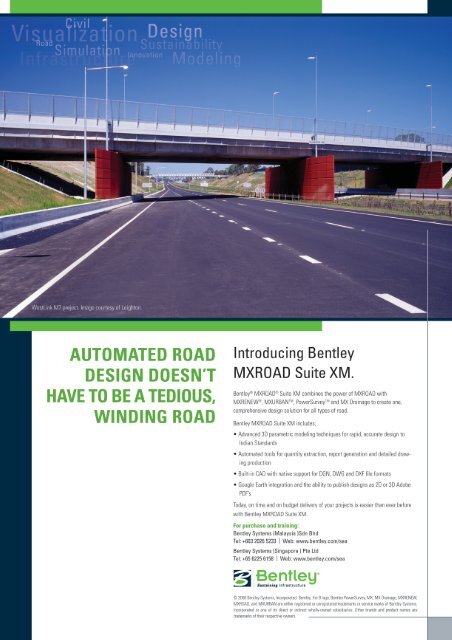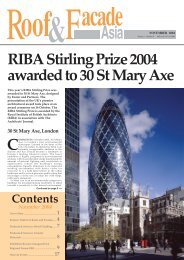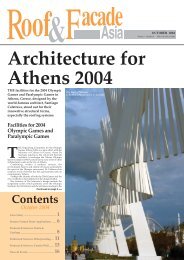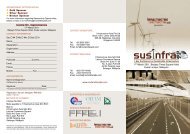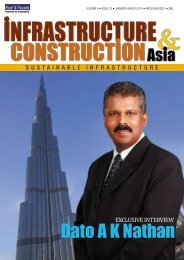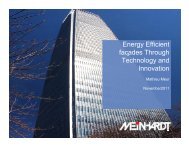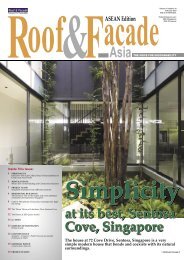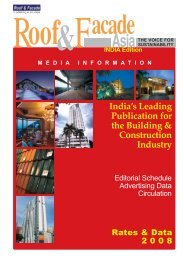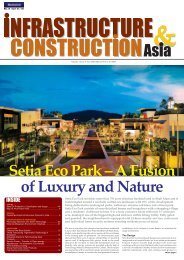Yangtze River Tunnel â A Project Of E&C ... - Roof & Facade
Yangtze River Tunnel â A Project Of E&C ... - Roof & Facade
Yangtze River Tunnel â A Project Of E&C ... - Roof & Facade
You also want an ePaper? Increase the reach of your titles
YUMPU automatically turns print PDFs into web optimized ePapers that Google loves.
Images Courtesy: Bentley Systems, Inc Images Courtesy: Bentley Systems, Inc<br />
TRANSPORTATION<br />
●From page 20<br />
in securing additional land. However, the<br />
exist-ing right-of-way proved to be minimal,<br />
so a large amount of private land had<br />
to be acquired. SWK India identified the<br />
additional land needed, generated the coordinate<br />
data, and staked the areas out on<br />
the ground before verifying and transferring<br />
the data back onto revenue maps used<br />
to contact landowners. This understanding<br />
and outcome had altered the social<br />
Designs & Returns<br />
The project report provided designs for the<br />
highway, pavement (with options for flexible<br />
or rigid pavement), overlay, bridges,<br />
cross-drainage structures, grade-separated<br />
structures, and service roads. SWK India<br />
calculated quantities for many items and<br />
Plan and profile of NH-9<br />
generated detailed working drawings as<br />
well as cost estimates. Other reports produced<br />
included the analyses of economic<br />
viability and environmental and social feasibility<br />
(with action plans as appropriate),<br />
as well as all documents needed for the bidding<br />
process.<br />
NHAI also required SWK India to include<br />
the kind of financial returns that<br />
could be generated through tolls and other<br />
revenues. It would use these to help attract<br />
private businesses to build and operate its<br />
new roads. During the process, SWK India<br />
found that while the stretch from<br />
Vijayawada to Vuyyuru was likely to have<br />
sufficient traffic for a build-operate-transfer<br />
operator to recover its costs, the stretch<br />
from Vuyyuru to Machilipatnam did not.<br />
Having this data meant NHAI was able to<br />
seek assurances from the Andhra Pradesh<br />
state government over the planned development<br />
of Machilipatnam as a deepwater<br />
port facility, there-by increasing the<br />
amount of goods transported on that<br />
stretch of roadway.<br />
Design in the Fast Lane<br />
Initial topographic surveys took three to<br />
four months to complete, and during this<br />
process SWK India was able to fix preliminary<br />
alignments. Once the survey data was<br />
available, the firm could check them<br />
against field conditions using MXROAD<br />
and complete the detailed engineering of<br />
121 kilometers of roadway. NHAI identified<br />
eight locations where bypasses could<br />
relieve congestion near towns. For each<br />
bypass location, SWK India prepared several<br />
alternative alignments before running<br />
a cost/benefit analysis on each. The bypass<br />
for the towns of Kodad and Pamaru<br />
proved to be particularly challenging, as<br />
the alignments had to be routed to minimize<br />
interference with agricultural fields,<br />
cart paths, field channels, and a major canal<br />
surrounding the towns.<br />
There were also situations in which a<br />
bypass had already been proposed and the<br />
land-acquisition process completed. In<br />
these cases, SWK India fixed the road alignment<br />
according to earlier plans using nondigital<br />
details provided by NHAI.<br />
In total, SWK India ended up designing<br />
nearly 200 kilometers of road because<br />
of the multiple alignment options required.<br />
For each case, SWK India used revenue<br />
maps to determine the extent of land acquisition<br />
already completed as well as the<br />
new land required along the centerline of<br />
the planned route.<br />
Finally, the road designs were evaluated<br />
for safety by outside experts. SWK<br />
India was able to create 3D visualisations<br />
of the project in order to convey sight distances<br />
and their suitability for the surrounding<br />
terrain along the road.<br />
Use of MXROAD, SWK India, had<br />
noted, enabled an integrated workflow that<br />
extended from processing the survey data<br />
all the way through to preparing land-acquisition<br />
plans, relocating utilities, and<br />
generating quantity takeoffs. The engineers<br />
prepared input files to create roadway<br />
edges, apply camber and super-elevation<br />
as well as create verges, shoulders, lay-bys,<br />
median openings, junctions, and earthwork<br />
styles. Managing the different phases<br />
of engineering design on a single platform<br />
helped ensure a consistent and uniform<br />
design product, even extending to small<br />
details such as linetypes and styles. The<br />
coordinated workflow ensured that different<br />
departments were always working on<br />
the current version of the design. ICA<br />
Volume 2 Issue 7 2008 ICA 21


